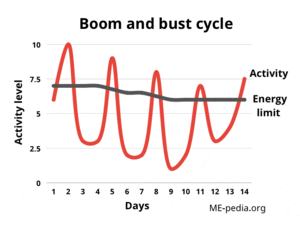Boom and bust activity cycle
The boom and bust cycle or over-activity and crash cycle is a common result when people with ME/CFS try to ignore and push through their symptoms.
Post-exertional malaise[edit | edit source]
Exceeding personal energy limits in ME/CFS results in post-exertional malaise (PEM): increased and debilitating symptoms that typically begin around 24 hours after exceeding limits, but may begin up to 3 days after. The delayed onset of PEM makes it difficult for patients to know when they are at or approaching their energy limit, which can cause the illness to feel very unpredictable. Post-exertional malaise may last days, weeks or longer, and even trivial activity may exceed someone's energy limit.
Boom and bust[edit | edit source]
When ME/CFS patients become worse after pushing through their symptoms, people with ME/CFS then have to choose again between rest or trying again to "push through" - which causes them to deteriorate further, until eventually they physically cannot continue. Both resting and pushing through result in an "greatly lowered ability to do activities that were usual before the illness", a symptom that is required for the diagnosis of ME/CFS.[1][2]
The cycle of repeatedly exceeding energy limits by doing too much activity or even pushing through symptoms followed by being forced to totally stop is called the "[boom and bust cycle", and is very widely recognized in ME/CFS, and in some patients without post-exertional malaise, including chronic pain and chronic fatigue patients.[3] A significant proportion of people with Long COVID report experiencing post-exertional malaise and find they have a boom and bust cycle.[4]
Consequences[edit | edit source]
The Canadian Consensus Criteria for ME/CFS states that the boom and bust cycle can result in more severe illness:
Pacing[edit | edit source]
Activity pacing or energy management is a way of planning and monitoring activity to try to avoid exceeding energy limits, in order to avoid the resulting periods of post-exertional malaise, which often forced patients to spend days in bed recovering.[6][5]
Different methods of pacing include pacing with a heart rate monitor, Energy Envelope Theory, and spoon theory.
See also[edit | edit source]
Learn more[edit | edit source]
References[edit | edit source]
- ↑ "Symptoms | Myalgic Encephalomyelitis/Chronic Fatigue Syndrome". Centers for Disease Control and Prevention. January 27, 2021. Retrieved February 25, 2021.
- ↑ NICE Guideline Development Group (October 29, 2021). "Myalgic Encephalomyelitis (or Encephalopathy)/Chronic Fatigue Syndrome:diagnosis and management. NICE guideline". National Institute for Health and Care Excellence.
- ↑ Antcliff, Deborah; Keenan, Anne-Maree; Keeley, Philip; Woby, Steve; McGowan, Linda. ""Pacing does help you get your life back": The acceptability of a newly developed activity pacing framework for chronic pain/fatigue". Musculoskeletal Care. n/a (n/a). doi:10.1002/msc.1557. ISSN 1557-0681.
- ↑ Horton, Simon MC; Poland, Fiona; Kale, Swati; de Lourdes Drachler, Maria; de Carvalho Leite, Jose Carlos; McArthur, Maggie A.; Campion, Peter D.; Pheby, Derek; Nacul, Luis (November 15, 2010). "Chronic fatigue syndrome/myalgic encephalomyelitis (CFS/ME) in adults: a qualitative study of perspectives from professional practice". BMC Family Practice. 11 (1): 89. doi:10.1186/1471-2296-11-89. ISSN 1471-2296. PMC 2994803. PMID 21078171.
- ↑ 5.0 5.1 Carruthers, Bruce M.; Jain, Anil Kumar; De Meirleir, Kenny L.; Peterson, Daniel L.; Klimas, Nancy G.; Lerner, A. Martin; Bested, Alison C.; Flor-Henry, Pierre; Joshi, Pradip; Powles, AC Peter; Sherkey, Jeffrey A.; van de Sande, Marjorie I. (2003). "Myalgic Encephalomyelitis/Chronic Fatigue Syndrome: Clinical Working Case Definition, Diagnostic and Treatment Protocols" (PDF). Journal of Chronic Fatigue Syndrome. 11 (2): 7–115. doi:10.1300/J092v11n01_02.
- ↑ Carruthers, BM; van de Sande, MI; De Meirleir, KL; Klimas, NG; Broderick, G; Mitchell, T; Staines, D; Powles, ACP; Speight, N; Vallings, R; Bateman, L; Bell, DS; Carlo-Stella, N; Chia, J; Darragh, A; Gerken, A; Jo, D; Lewis, DP; Light, AR; Light, KC; Marshall-Gradisnik, S; McLaren-Howard, J; Mena, I; Miwa, K; Murovska, M; Stevens, SR (2012), Myalgic encephalomyelitis: Adult & Paediatric: International Consensus Primer for Medical Practitioners (PDF), ISBN 978-0-9739335-3-6


